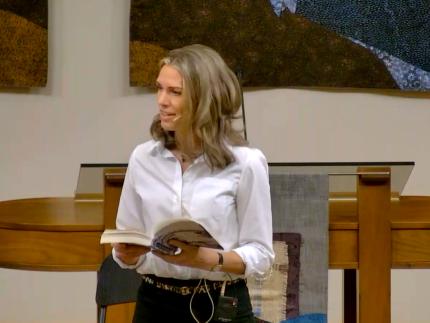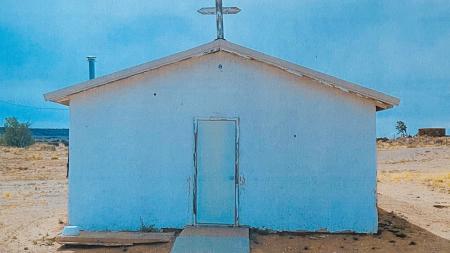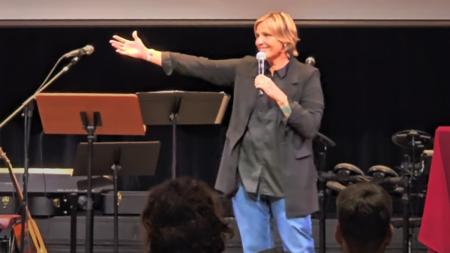Sharing Stories and Memories from WWII

A good story well told can inspire people and cause them to think or rethink about the world and their lives. With that idea in mind, Meadowlands Fellowship Christian Reformed Church of Ancaster, Ont., brought together author Lena Scholman and a panel of three people who were children in the Netherlands during World War II, inviting them to share their stories and memories.
The evening event on Mar. 30 included an interview between emcee Syd Hielema and Scholman; a reading of excerpts from her novel, Between Silk and Wool; a panel discussion with three members of Meadowlands Fellowship CRC who lived through the war; and a closing time when members of the audience could share their stories or questions.
Scholman, an author and researcher who has written a blog since 2017 and shares a series of short stories on her website, has had her writing published in the Hamilton Spectator, the Toronto Star, and the Globe and Mail. Between Silk and Wool: A Novel of Holland and the Second World War (Carpe Diem, 2022) is her first novel. She also serves as academic lead for Redeemer University’s Act Five program.
In the interview, Scholman shared about her family’s storytelling history, her decision to place her novel in the Netherlands during World War II, and about the writing process.
Scholman explained that as part of a writing group, she shared a short story she had written about a father and a daughter and some conflict between them. “And the group rejected it,” she said, “on the basis that, as they put it, ‘This is not a short story; this is a novel.’ [That’s the] last thing you want to hear from your writing group – when you write 1,000 words, and they tell you to write 100,000 more. So that’s where it began.”
Growing up in agricultural circles among Dutch immigrants in Ontario, Scholman said, she was familiar with some stories of Dutch experiences during the war, but as she started the novel she became curious about the experiences of people who didn’t end up immigrating – particularly people more wealthy or established. She also became interested in the Jewish experience in the Netherlands.
Research and background for the novel thus involved reading primary and secondary sources, letters, personal memoirs, diaries, and family projects, she said. Scholman also traveled to the Netherlands. “[I went there] just to get a feeling, to try and get some of the details right. It was a really wonderful experience. And actually to see how much things had changed. I wanted to see Camp Westerbork for myself, but the way it’s described in the 1930s and the way it is now are not the same. . . . You can go to Holland to do research, but you can’t go back in time.”
As she wrote, Scholman said, she started out with one main character, and that grew to two and then three. A fourth major character came to mind from a scene in the developing story. “It was just an experiment,” she said. “I brought the scene to my writing group, and they said, ‘This guy stays.’ So, he stayed.” She noted that sometimes her research intersected with the plot in ways that made her take the plot in a certain direction. And the story lines of each major character began to interweave as the novel went on.
Scholman noted, “One of the things that was a real honor for me was the opportunity to be entrusted with other people’s stories. It started with my grandparents’ stories, but there are some stories that people weren’t willing to share for many, many years, and I just felt really privileged when people opened up to me and told me stories that they had never told anyone else before. And some of those details are in the novel. There are parts in the novel which are from my own family, little clues for them, because I’m the one in the family who took bits and pieces and threaded them into a novel. So it’s a novel; it’s not ‘true,’ but [in it] there are little waves and nods to my family.”
The excerpts from Between Silk and Wool that Scholman chose to read at the event showcased the major characters and highlighted the themes of the evening: “Ignoring, Resisting, and Surviving Occupation in WWII.”
The author’s reading set the stage for a panel of three people to share their experiences of the war: Harry and Nienke Van Dyke and Johanna Wynands – all members of Meadowlands Fellowship CRC.
Harry Van Dyke and Wynands grew up near Rotterdam, one of the hardest hit areas of the Netherlands during the war. Nienke Van Dyke grew up near Enschede, in the central eastern part of the country. On “Liberation Day” at the end of the war for the Netherlands, May 5, 1945, Harry was five years old, Nienke was six years old, and Wynands was 13 years old.
Wynands related how on May 10, 1940, she and her brother saw planes coming from the east, and they jumped in excitement. The plane dipped a wing in response to their waves. A neighbor came out and told them not to interact with the plane, saying, “Look what it’s going to do.” They ran around the house and looked toward Rotterdam, and they saw bombs falling and plumes of smoke. In the following days, people came from the city to stay with them for safety and shelter. Wynands said her father was a baker in Rotterdam, and he did not return for several days after the initial bombing; he had been helping with rescue and recovery.
Harry Van Dyke shared a story about the fear and anxiety people lived with during the days of the war, reading a memory his father had written down before he died. His father had been in the Dutch reserves. In early May 1940, he was home on leave for the birth of his son and was able to spend four days with his family. One of the days was a Sunday, and, unsure of what might happen or when he might be home again, he and his wife decided to have their son baptized that day. That evening, he had to report back to the field, as things were looking grim. So he left his wife, two toddlers, and a four-day-old baby and headed with his unit to the German border. Shortly afterward, Nazi Germany launched a full attack and occupied the whole country within days. He became a prisoner of war but was released by the end of May, since he was a farmer and his work was needed in the food industry.
Wynands told the audience about her uncle by marriage, who was of German heritage and had joined the SS, an elite corps of the Nazi army, when the war began – a decision that was very hard on the family. In 1943 his wife took their children on the train to join him in Germany, but the train was bombed and she was injured. She and the children lived out the rest of the war in Rotterdam.
Wynands continued, “After the war, he came back from Germany. He said to his wife that he was totally wrong and that he wanted to go and get his punishment like everybody else. So he [surrendered] himself and went to jail. He was in jail for a year and a half, and he came back a broken man – but also a man who really knew that what he had done in wartime was really wrong. He came to ask forgiveness of my grandfather, my father, and mother. . . . They were in a front room, and they stayed in there for an hour. . . . And, as children, we wanted to know what was happening, because [our uncle] was a traitor. What was he going to do? But he was different. Opa told us that we should also see that [our uncle] had had his punishment, but also that Christ died for our sins. We are not without any sin either. That was the lesson we got.”
Nienke Van Dyke told of a cousin who became a soldier for Germany, which was very difficult for the family. When his father died, he consented to attend the funeral in civilian clothes rather than his Nazi uniform, out of respect for the rest of the family. After the funeral, he came to Nienke’s family’s home unexpectedly for coffee, not realizing the family had two Jews hiding upstairs. He never knew, and he left without incident.
Hiding Jewish people had its difficulties and complexities, Nienke shared: “How do you get food rationing coupons for everybody? Your milkman comes to the door, and he knows you have a family of three – so you have to go to another milkman to buy milk. And you can’t always go to the same milkman, because that milkman will say, ‘What’s the matter with these people? Don’t they have the milkman coming to their door? Why do they have to come to my shop to pick it up?’ Same with bread. Same with almost anything. And laundry – you can’t hang your wash outside because, you know, there’s only one man in the family, and all of a sudden you’ve got three pairs of male pajamas hanging outside – that kind of stuff. . . . They played it by ear, and every day they’d have a new challenge.”
When people came to the door, she said, they had a code of knocking on the pipe so that strangers wouldn’t hear their Jewish guests walking around upstairs. They shared good times as well, she said; on some evenings they played Scrabble, talked about books, and occasionally even had hot chocolate. One day, she added, it came home to her family how dangerous their situation was. They found out that while they had enjoyed a good evening of visiting with their guests, a family across the road that was also harboring Jews had been discovered by the Nazis. Their guests were shot and killed, and the family was taken away.
But despite the danger, Nienke Van Dyke said, “In the end they were all saved – the people at my parents’ house. They went into this [situation] believing this was what God wanted them to do. They prayed every night, and they trusted that God would look after them one way or another – and that faith was rewarded.”
The three shared more stories, noting tricky relationships and interactions in a society under occupation, the Resistance movement, collaborators, decisions made in uncertain times, and how the war shaped the country and its people for decades to come. A recording of the evening is available on the website of Meadowlands Fellowship CRC.
The event was hosted by the church’s antiracism committee. Commenting on the committee’s decision, Hielema noted, “Racism was at the heart of World War II, with the Nazis seeking to create the super Aryan race and exterminate the Jewish race. Thus, all acts of resistance were antiracist acts that continue to inspire antiracism work today.”


